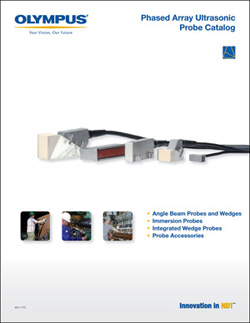Phased Array Probe Selection Summary
Designing phased array probes is always a compromise between selecting the proper pitch, element width and aperture. Using a high number of small elements to increase steering, reduce side lobes and provide focusing but can be limited by cost of manufacturing and instrument complexity. Most standard instruments will support apertures of up to 16 elements. Separating elements greater distances may seem the easy way to gaining aperture size, but this creates unwanted grating lobes.
It is important to note that vendors of phased array transducers often offer standard probes that have been designed with these compromises in mind, resulting in optimized performance for the intended use. Actual transducer selection will ultimately be driven by the end application needs. In some cases multi-angle steering will be required over small metal paths so large aperture sizes are not needed or desired. In other cases the application may be to cover large areas for laminar defects will
require large apertures and linear scan format with multiple grouped elements where steering is not required at all. In general, the user can apply best practice from their conventional UT knowledge for frequency and aperture selection.
The graphic below is a link to the Olympus NDT phased array probe catalog. Click on it to view the full selection of probes and wedges that is available.
Continue on to Chapter 3
Imaging Basics >>
